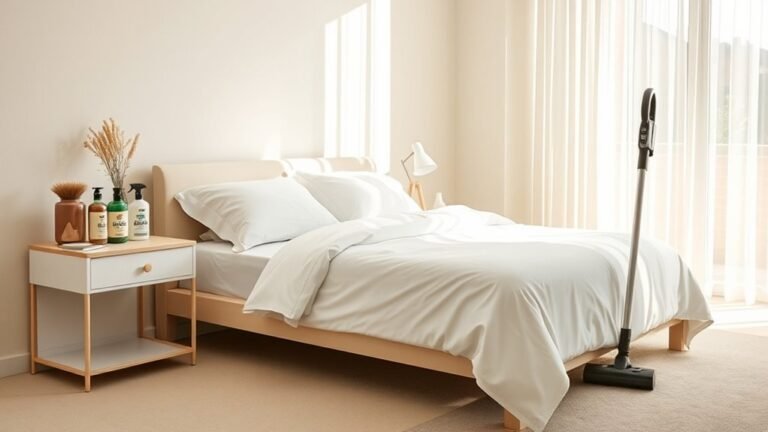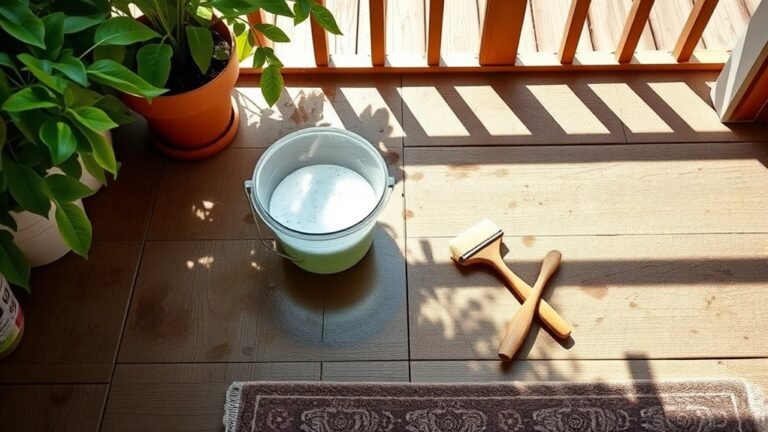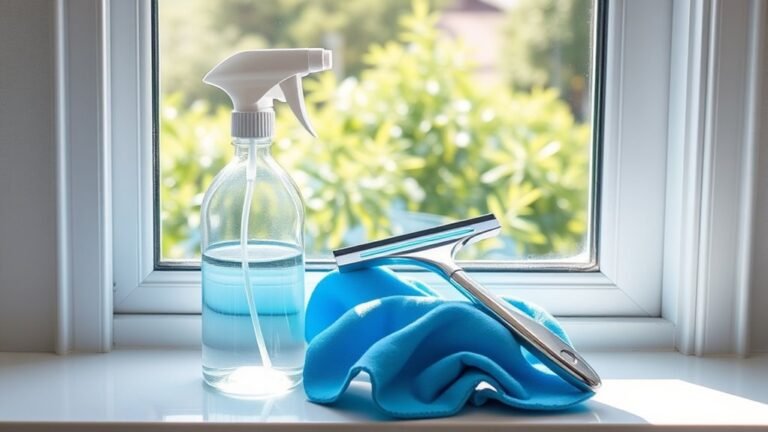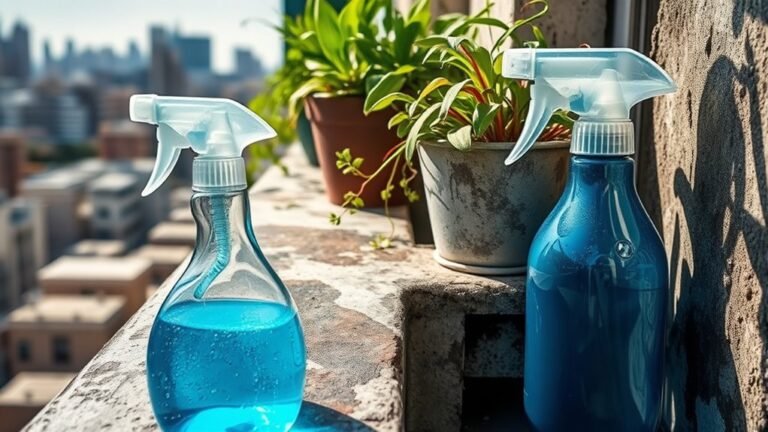How to Clean Living Room Upholstery
To clean your living room upholstery, first identify the fabric type and choose safe cleaning supplies. Vacuum thoroughly using soft attachments, then spot-test cleaners on a hidden area. Quickly treat stains by blotting, never rubbing. For deeper refreshment, steam clean and deodorize with baking soda and essential oils. Guarantee proper drying by maximizing airflow to prevent mold and fading. With regular care, your upholstery stays fresh and inviting. Keep going to discover expert tips for maintaining your furniture’s look and feel.
Identify the Fabric Type

Before you start cleaning, you’ll need to identify the fabric type of your living room upholstery. Knowing whether your furniture is made of natural fibers or synthetic fabrics gives you the freedom to choose the best cleaning method without risking damage. Natural fibers like cotton, wool, or linen tend to absorb liquids quickly, so they require gentler cleaning solutions. Synthetic fabrics such as polyester or nylon are often more durable and stain-resistant, letting you use stronger cleaners if needed. You can usually find a fabric tag with cleaning codes or look closely at the weave and texture to tell them apart. Taking this step empowers you to protect your furniture and keep your living space looking fresh without restrictions or unnecessary worry.
Gather Necessary Cleaning Supplies
Before you start cleaning, make sure you have all the essential tools like a vacuum, soft brushes, and microfiber cloths. Pick cleaners that are safe for your fabric type to avoid damage. Also, prepare the upholstery surface by removing cushions and loose debris for the best results.
Essential Cleaning Tools
To tackle cleaning your living room upholstery effectively, you’ll need a few essential tools. These will help you refresh your furniture without hassle, keeping your space vibrant and free. Here’s what to gather:
- Fabric brushes – perfect for loosening dirt deep in the fibers without damaging the fabric.
- Upholstery sprays – designed to lift stains and refresh odors, making your furniture feel like new.
- Vacuum cleaner with an upholstery attachment – to suck up dust and debris efficiently.
- Soft, lint-free cloths – ideal for gentle wiping and drying without leaving residue.
With these tools in hand, you’re set to take control of your upholstery’s cleanliness and enjoy a living room that feels truly yours.
Choosing Safe Cleaners
Although choosing the right cleaners might seem straightforward, it’s important to pick products that are safe for your upholstery’s fabric and your home environment. You want to avoid harsh chemicals that could damage your furniture or harm your indoor air quality. Opt for eco friendly cleaners that are gentle yet effective. These products not only protect the fibers of your upholstery but also minimize your environmental footprint. Look specifically for fabric safe options labeled for your upholstery type, whether it’s cotton, microfiber, or leather. By selecting these safer alternatives, you maintain your freedom to enjoy a fresh, clean living room without worrying about toxic residues or fabric damage. Keep your space vibrant and healthy with smart, conscious choices in your cleaning supplies.
Preparing Upholstery Surface
Gathering the right cleaning supplies is the first step to effectively preparing your upholstery for a deep clean. With the right tools, you’ll breeze through the job and protect your fabric. Here are essential items to have on hand:
- A vacuum with upholstery attachments for removing loose dirt and dust.
- Mild detergent or a fabric-safe cleaner chosen based on your upholstery type.
- Soft-bristle brushes or microfiber cloths for gentle scrubbing and wiping.
- A spray bottle filled with water to lightly dampen fabric during cleaning.
These upholstery preparation tips guarantee you use proper cleaning surface techniques without damaging your furniture. By organizing your supplies beforehand, you set yourself free from stress and can confidently restore your living room’s comfort and appearance.
Vacuum Upholstery Thoroughly
Make sure you use the right vacuum attachments to protect your upholstery while getting a deep clean. Pay special attention to crevices and seams where dust and crumbs tend to hide. This step will help remove dirt and prepare your furniture for the next cleaning phase.
Use Appropriate Vacuum Attachments
Before you start vacuuming your living room upholstery, it’s important to choose the right vacuum attachments to guarantee a thorough clean without damaging the fabric. Using the proper tools helps you maintain freedom from stubborn dirt while protecting your furniture. Here are four upholstery tips to keep in mind:
- Use a soft brush attachment to gently lift dust and pet hair without scratching.
- Try the crevice tool for easy access to tight spots without harming delicate fibers.
- Opt for a wide upholstery nozzle to cover broad areas quickly and efficiently.
- Avoid beater bars or stiff brushes that can wear down fabric and reduce your upholstery’s lifespan.
Selecting the right vacuum attachments assures you clean effectively, preserving your freedom to enjoy a fresh and inviting living space.
Focus on Crevices and Seams
Although it’s tempting to focus on the main surfaces, you shouldn’t overlook the crevices and seams when vacuuming your upholstery. These hidden spots often trap dirt and debris, so thorough crevice cleaning is crucial. Take time for a careful seam inspection to catch buildup that dulls your furniture’s look. Using the right tools, like a crevice nozzle, lets you reach tight areas easily, guaranteeing freedom from hidden grime.
| Task | Tool Needed | Benefit |
|---|---|---|
| Main Surface | Upholstery brush | Quick dirt removal |
| Crevice Cleaning | Crevice nozzle | Deep dirt extraction |
| Seam Inspection | Handheld vacuum | Identifies hidden buildup |
| Edge Cleaning | Narrow attachment | Cleans hard-to-reach spots |
| Final Check | Light source | Guarantees no spot missed |
Focus on these areas for fresher, cleaner upholstery every time.
Spot Test Cleaning Solutions

Where should you test your cleaning solution to avoid damaging your upholstery? You want to pick a hidden spot where any reaction won’t be obvious. Testing verifies the cleaning solutions you choose are safe and have good fabric compatibility. Follow these simple steps:
- Locate an inconspicuous area like under a cushion or the back of the sofa.
- Apply a small amount of the cleaning solution.
- Wait 10-15 minutes to watch for any discoloration, shrinking, or texture changes.
- If the fabric remains unchanged, you’re good to clean the rest confidently.
Taking this quick test lets you maintain your freedom to clean without fear of ruining your furniture. It’s a smart step that protects your investment and keeps your living room looking fresh.
Remove Stains With Appropriate Methods
When you spot a stain on your upholstery, acting quickly can make all the difference in removing it effectively. Different stain types—like grease, wine, or ink—demand specific cleaning methods to avoid damage. For grease stains, sprinkle baking soda to absorb oil before gently blotting with a mild detergent solution. Red wine requires blotting with a clean cloth and applying a vinegar and water mix carefully. Ink stains might need rubbing alcohol applied sparingly. Always blot, never rub, to prevent spreading. Understanding your stain types lets you choose the right approach, giving you control over your upholstery’s care. By tailoring your cleaning methods to the stain, you keep your living room looking fresh without relying on harsh chemicals or professional help.
Use a Steam Cleaner for Deep Cleaning

Harness the power of a steam cleaner to give your living room upholstery a thorough, deep clean. Steam cleaner benefits include killing bacteria, removing deep-seated dirt, and rejuvenating fabric without harsh chemicals. To maximize upholstery maintenance, follow these steps:
- Vacuum your upholstery first to remove loose dirt and dust.
- Fill your steam cleaner with water and allow it to heat fully.
- Test a small, hidden area to check fabric compatibility.
- Slowly move the steam cleaner over the fabric, avoiding over-saturation.
Using a steam cleaner frees you from frequent harsh cleaning and extends the life of your furniture. It’s an efficient way to keep your living space fresh and inviting without sacrificing your independence or time.
Dry Upholstery Properly
Although cleaning your upholstery is essential, drying it properly is just as important to prevent mold and odors. You want to embrace effective drying techniques that maximize air circulation for quick, thorough drying. Open windows, use fans, or even a dehumidifier to keep fresh airflow moving around your furniture. Avoid direct sunlight to prevent fabric fading.
| Drying Technique | Benefits | Tips |
|---|---|---|
| Air Drying | Natural, energy-saving | Open windows, use fans |
| Dehumidifier | Controls moisture levels | Place near upholstery |
| Avoid Direct Sunlight | Prevents color fading | Use curtains or shade |
| Fan Use | Speeds evaporation | Position for maximum airflow |
| Quick Check | Detects damp spots | Touch surfaces after drying |
Master these, and your freedom to enjoy fresh, clean upholstery is secure.
Deodorize to Eliminate Odors
Since odors can linger even after cleaning and drying, you’ll want to deodorize your upholstery to keep your living room smelling fresh. Here’s how to do it with ease and freedom:
- Sprinkle a generous layer of baking soda evenly over the upholstery. It naturally absorbs odors without harsh chemicals.
- Add a few drops of your favorite essential oils—like lavender or eucalyptus—to the baking soda for a revitalizing scent boost.
- Let the mixture sit for at least 15 minutes, longer if you can, to maximize odor elimination.
- Vacuum the baking soda thoroughly, making sure to reach every corner and crevice.
This simple routine frees your space from unwanted smells, making your living room inviting and comfortable again.
Maintain Upholstery Regularly
After deodorizing, keeping your upholstery in good shape requires regular care. You’ll want to develop a regular cleaning schedule that fits your lifestyle, so your living room stays fresh and inviting without hassle. Start by vacuuming your furniture weekly to remove dust and debris that can wear down fabric fibers. Use upholstery maintenance tips like spot cleaning spills immediately with a gentle cleaner to prevent stains from setting. Rotate cushions regularly to guarantee even wear and maintain their shape. Don’t forget to check manufacturer guidelines before using any cleaning products. By sticking to these simple routines, you free yourself from major cleaning headaches later and keep your living space feeling open, comfortable, and truly yours.
Frequently Asked Questions
Can Upholstery Cleaning Damage Antique Furniture?
You might worry that upholstery cleaning could damage antique furniture, and that’s a valid concern. If you want to protect fabric preservation, you’ve got to choose gentle cleaning techniques specifically designed for delicate materials. Avoid harsh chemicals or aggressive scrubbing, as these can wear down fibers or alter colors. By using proper methods, you can maintain your furniture’s charm without sacrificing the freedom to keep it fresh and inviting.
How Often Should Professional Upholstery Cleaning Be Done?
You’ll want to follow frequency recommendations that suit your lifestyle and upholstery type. Generally, a professional cleaning every 12 to 18 months keeps things fresh without overdoing it. If you have kids, pets, or allergies, you might want to tighten up your cleaning schedule to every 6 to 12 months. Ultimately, you’re free to adjust based on how much wear and tear your furniture sees, ensuring it always looks its best.
Are Natural Cleaning Products Safe for All Fabric Types?
Imagine using lemon juice on a silk scarf only to find it faded—natural cleaners aren’t always gentle on every fabric type. While they’re great for freeing you from harsh chemicals, natural cleaners can sometimes harm delicate materials. You’ve got to test a small hidden spot first to avoid surprises. So, even though natural cleaners feel safer, they’re not universally safe for all fabrics. Always check fabric care labels!
What Are Signs Upholstery Needs Replacement Instead of Cleaning?
You’ll know it’s time to replace your upholstery when fabric wear becomes too obvious—think thinning, tears, or sagging that no cleaning can fix. If stains have become permanent, resisting every attempt to freshen them up, that’s another sign. Don’t feel tied down by old, tired furniture; swapping out worn upholstery can free your space and spirit, letting you enjoy a fresh, comfortable vibe without the hassle of endless cleaning battles.
Can Pets Affect the Longevity of Upholstery Fabric?
Absolutely, pets can impact how long your upholstery lasts. If you want your furniture to hold up, choosing pet friendly fabrics is key—they resist scratches and stains better. But no matter what, regular upholstery maintenance is a must to keep things looking fresh and comfy. You don’t have to sacrifice style or freedom; with the right care and fabric choices, your living space can stay cozy and pet-friendly without constant worry.






